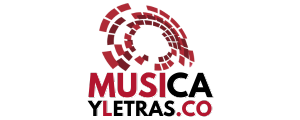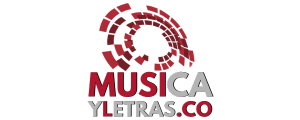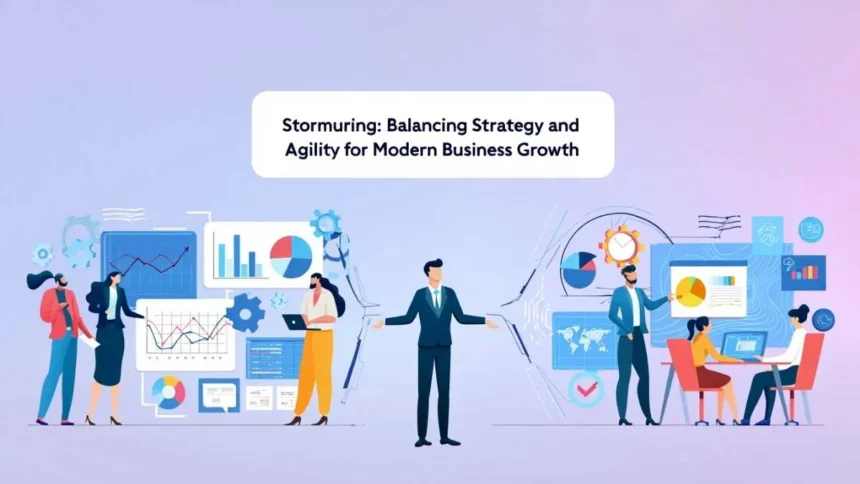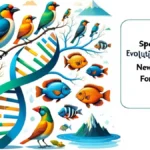Stormuring is a progressive business and strategic concept that merges structured planning with adaptive execution to help companies thrive in unpredictable markets. It answers a vital question: What is stormuring, and how can it help businesses stay strong amid rapid change?
- What Makes Stormuring Essential in Modern Strategy?
- The Four Core Elements of Stormuring
- Stormuring versus Traditional Business Strategy
- Benefits of Adopting Stormuring
- How to Implement Stormuring in an Organization
- Examples in Action
- Potential Challenges and How to Overcome Them
- Why Stormuring Is the Future of Strategic Management
- FAQs
- Conclusion
In essence, it empowers organizations to maintain stability through clear frameworks while staying agile and innovative. It’s the art of balancing strategic clarity with organizational flexibility, allowing businesses to anticipate, respond, and evolve. In today’s ever-changing landscape, this approach ensures sustained performance, resilience, and relevance across global and local markets.
What Makes Stormuring Essential in Modern Strategy?
At its foundation, it unites two ideas, structure and storm. It represents an enterprise’s ability to endure unpredictable challenges while using them as catalysts for growth. Instead of resisting disruption, it teaches companies to embrace uncertainty as a strategic advantage.
Traditional planning relies on rigid blueprints, while stormuring promotes strategic adaptability, a dynamic way to plan, execute, and innovate simultaneously. It’s about maintaining direction while allowing freedom to pivot. This balance makes stormuring a future-ready framework for organizations navigating evolving markets, customer demands, and technologies.
The Four Core Elements of Stormuring
The success of stormuring rests on four key pillars that define its structural and flexible nature:
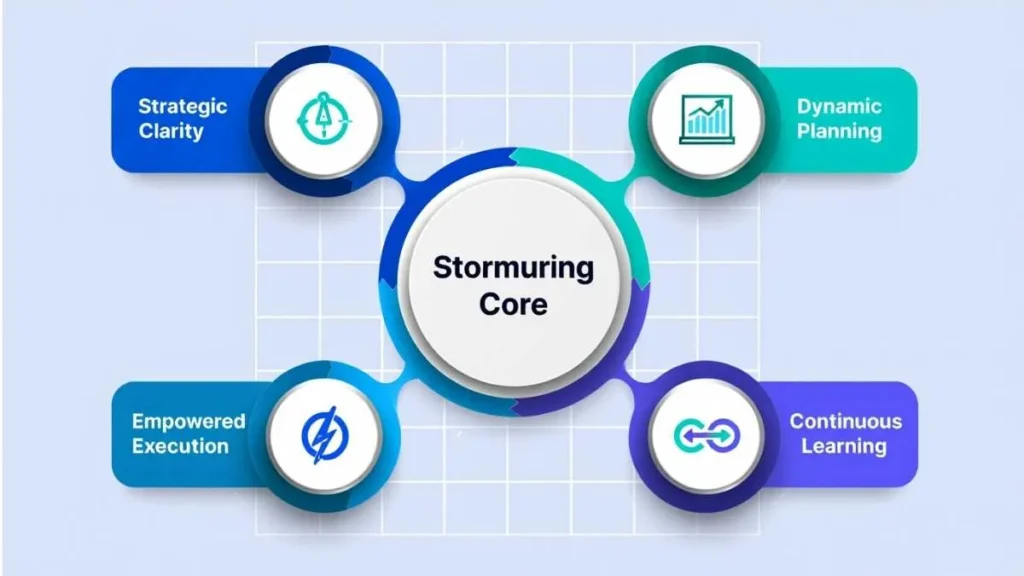
1. Strategic Clarity
Every organization practicing stormuring begins with a crystal-clear mission and purpose. This clarity keeps teams aligned even during change. Instead of strict plans, leaders focus on north-star objectives, guiding principles that remain stable while methods evolve.
2. Dynamic Planning
Rather than setting plans once a year, stormuring encourages continuous, data-driven planning. Teams analyze results, market trends, and customer insights in real time, updating strategies regularly. This ensures businesses stay relevant and ahead of competitors.
3. Empowered Execution
Execution in an it environment relies on autonomy and accountability. Teams are trusted to make smart decisions within set boundaries, promoting creativity and speed. Empowerment boosts morale, fosters innovation, and accelerates decision-making.
4. Learning Feedback Loops
Constant learning keeps stormuring effectively. Every project and performance review contributes insights that refine future actions. Mistakes are treated as lessons, forming a culture of iterative improvement that strengthens innovation and adaptability.
Stormuring versus Traditional Business Strategy
| Aspect | Traditional Planning | Stormuring Approach |
| Mindset | Predict and control | Prepare and adapt |
| Goal Nature | Fixed long-term targets | Flexible, evolving objectives |
| Execution Style | Centralized and top-down | Distributed and autonomous |
| Response to Change | Reactive | Proactive and anticipatory |
| Learning Frequency | Annual reviews | Continuous improvement |
Benefits of Adopting Stormuring
Implementing stormuring yields measurable advantages across multiple organizational dimensions:
- Improved Agility: Quick adaptation to market shifts and disruptions.
- Enhanced Innovation: Encourages experimentation within safe, strategic boundaries.
- Increased Resilience: Builds systems capable of sustaining shocks and maintaining progress.
- Employee Empowerment: Boosts ownership, collaboration, and productivity.
- Sustained Growth: Enables companies to remain competitive and forward-focused.
How to Implement Stormuring in an Organization
The transition to it involves cultural, procedural, and strategic shifts. Here’s how to apply it step by step:
1. Redefine Leadership Roles
Leaders act as enablers, guiding teams with strategic intent rather than micromanagement. Their job is to align, inspire, and empower.
2. Build Clear but Flexible Frameworks
Create boundaries for decisions, budgets, and timelines, then allow flexibility within them. This prevents confusion while maintaining creativity.
3. Encourage Cross-Functional Collaboration
Adaptive teams with diverse expertise enhance responsiveness and problem-solving. Collaboration bridges departments and accelerates innovation.
4. Adopt Agile Technologies
Use digital dashboards, predictive analytics, and agile project tools for real-time updates and decision-making. This technological infrastructure fuels strategic agility.
5. Foster a Learning Ecosystem
Make learning continuous. Regular feedback sessions, retrospectives, and innovation sprints ensure insights are applied quickly and effectively.
Examples in Action
Several global companies demonstrate stormuring’s principles in real-world business strategy:
- Amazon continuously experiments while maintaining a strong strategic direction. Its flexibility across divisions, like AWS, logistics, and AI, embodies stormuring at scale.
- Tesla balances long-term sustainable energy goals with rapid product and manufacturing innovation.
- Unilever applies dynamic planning, empowering regional teams to adapt products locally while adhering to a unified global vision.
Potential Challenges and How to Overcome Them
While it offers many benefits, it also introduces new challenges:
- Cultural Resistance: Employees accustomed to hierarchy may fear autonomy.
- Balancing Freedom and Structure: Too much flexibility can cause confusion; too much structure stifles innovation.
- Measurement Complexity: Traditional KPIs often miss agility-based progress; new metrics must track learning and adaptability.
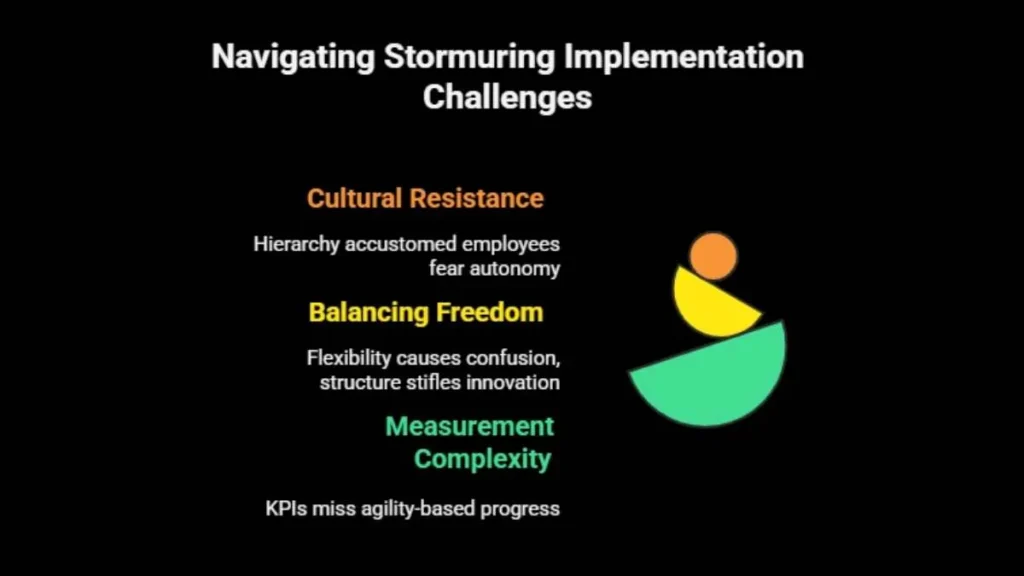
Solution: Start small. Implement stormuring gradually within select teams, measure adaptability improvements, and expand organization-wide once cultural alignment develops.
Why Stormuring Is the Future of Strategic Management
In the era of digital transformation, global interdependence, and economic volatility, it is emerging as the new foundation of competitive strategy. It complements existing frameworks like Agile, OKRs, and Design Thinking, but integrates them into a unified philosophy of controlled adaptability.
FAQs
Q1: How does it differ from agile management?
A1: It integrates agile methods within a strategic framework, adding long-term vision to short-term adaptability.
Q2: Can small businesses apply stormuring effectively?
A2: Absolutely. Even small teams benefit from structured flexibility to react faster and innovate smarter.
Q3: Is stormuring suitable for non-tech industries?
A3: Yes. Stormuring applies to any sector, manufacturing, education, or healthcare, seeking sustainable adaptability.
Conclusion
It is more than a business tactic; it’s a philosophy of balance. By merging structure and flexibility, it empowers companies to remain strategic, responsive, and resilient.
In an unpredictable world, it transforms uncertainty into momentum. It is the key to future-proofing businesses, ensuring they evolve gracefully while staying grounded in purpose and direction.
